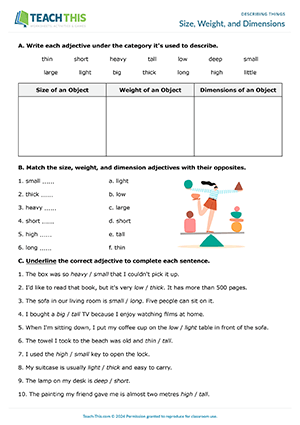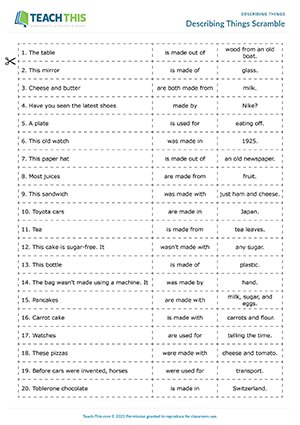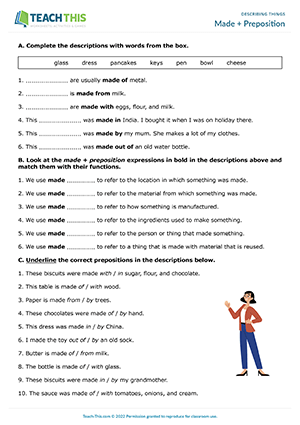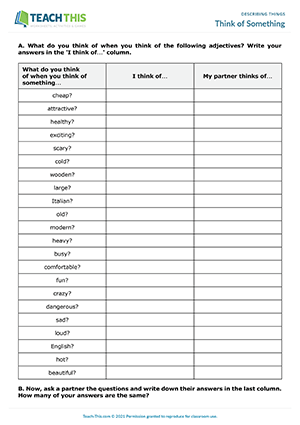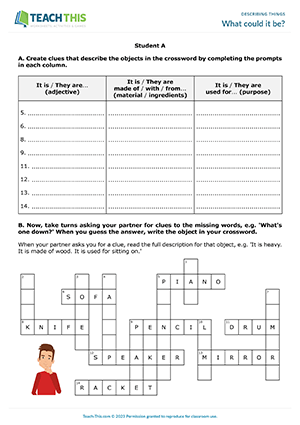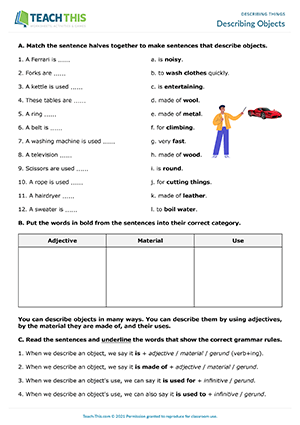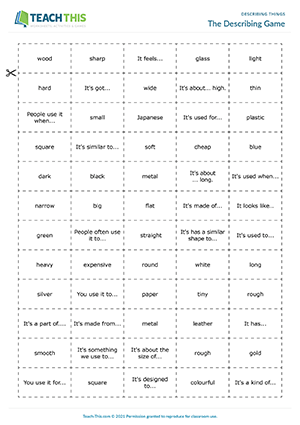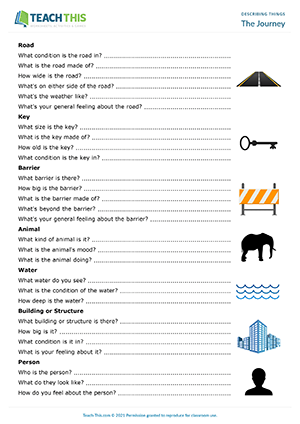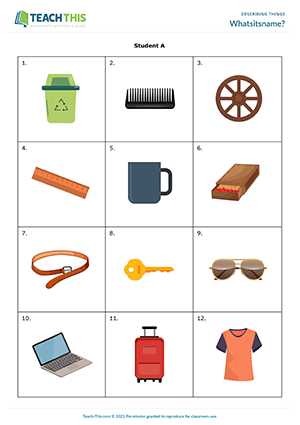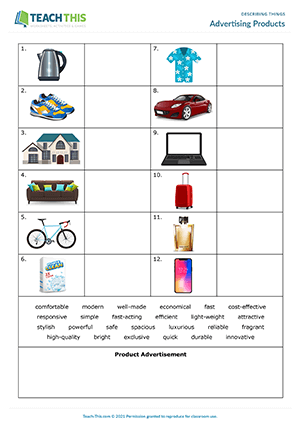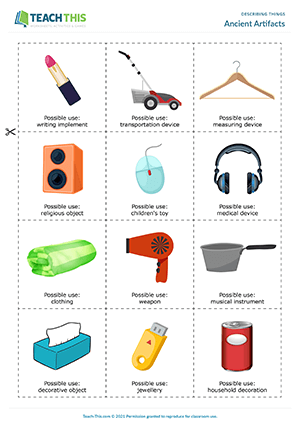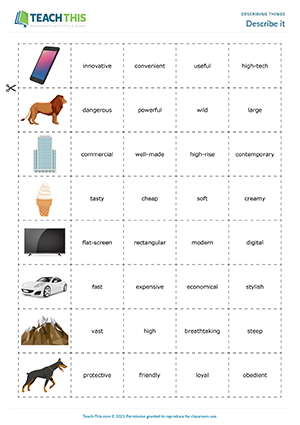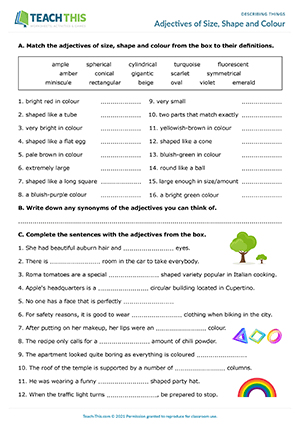In this useful describing objects worksheet, students practice adjectives used to describe the size, weight, and dimensions of objects. First, students write each adjective under the category that it is used to describe. Next, students match size, weight, and dimension adjectives with their opposites. Students then underline the correct size, weight, or dimension adjective to complete each sentence about an object. After that, students complete sentences about objects by choosing the correct size, weight, or dimension adjective from the options given. Finally, students complete sentences about objects and their size, weight, and dimensions with their own ideas and then compare their answers with a partner.
In this productive describing things game, students race to form descriptions with made or used + preposition expressions. In pairs, students begin by separating cards into three types and placing them face-up on the table (sentence beginning cards, made / used + preposition cards, and ending cards). Next, students line up the sentence beginning cards in order and match each one with an ending card. After that, students complete each sentence with a made / used + preposition card, e.g. 'This mirror is made of glass'. The first pair to complete all the descriptions correctly wins.
In this comprehensive describing things worksheet, students learn how to describe things with made + preposition expressions. First, students complete descriptions with words from a box. Next, students look at the made + preposition expressions in bold in the descriptions and match them with their functions. Students then underline the correct preposition in each description. After that, students complete descriptions with the prepositions: in, of, from, with, by or out of. Next, students match sentence halves together, adding a suitable preposition. Lastly, students complete descriptions with the correct preposition. Students then work with a partner and try to think of one thing to complete each description.
In this fun describing things activity, students associate words with adjectives and compare their answers with a partner. Working alone, students go through the questions on the worksheet and write something that they associate with each adjective. In pairs, students then ask their partner the questions from the worksheet and write down their answers. Afterwards, students compare their answers with their partner and see if they both thought of the same things or not. Finally, there is a class feedback session to find out which associations the students have in common and to speculate why. As an extension, students choose five of the adjectives from the worksheet and write as many things they associate with them as possible. Students then read the list of items to the class who tries to guess the adjective.
In this useful describing things speaking activity, students describe and guess everyday objects. In two groups, students invent and write down clues that describe the objects in their crossword by completing prompts in each column of a table. Next, students pair up with someone from the other group and take turns asking their partner for a clue to one of their missing words. Their partner reads out the clue for that word, e.g. 'It is heavy. It is made of wood. It is used for sitting on.' If the other student guesses the object successfully, they write it on their crossword. If not, their partner continues to give more clues until the student is able to guess the object. When the students have finished, they compare their crosswords to ensure that the spellings are correct.
This free describing objects worksheet helps students learn how to describe things using adjectives, the materials they're made of, and their use. Students begin by matching sentence halves together to make sentences that describe objects. Next, students put the words in bold from Exercise A into their correct category: adjective, material, or use. After that, students read about describing objects and underline words that show the correct grammar rules. Students then move on to complete sentences that describe objects with the words shown. Next, students write three sentences of their own to describe six objects using the words provided. In the last exercise, students think of two objects and describe them in three sentences to a partner, without saying what the objects are. Their partner then tries to guess what they are describing.
In this engaging describing things game, students describe things that come from different countries. Each pair is given a set of cards that show things countries are famous for, such as types of food, animals, sports, company names, products, etc. In pairs, students take it in turns to pick up a card and give clues about what is on the card to their partner. The first clue must be about the nationality of the thing being described, e.g. 'It is Australian'. Their partner then tries to guess the answer. If they guess correctly the first time, they score five points. If they guess incorrectly, the student gives another clue for four points and so on. The student with the most points at the end of the game is the winner.
In this creative describing things game, students describe objects with five given words or phrases. Players take it in turns to turn over the top five cards from the pile. The player then thinks of an object and tries to use the five words or phrases on the cards to describe it. The player must make one sentence per card. The other students in the group judge whether each sentence the player makes is acceptable. When a player has used a card successfully to describe their object, the player keeps the card. The player with the most cards at the end of the game wins.
In this imaginative describing things activity, students describe in detail the things they see as they are led on a journey. Tell the students that they are going to go on a journey using their imagination. As students approach each situation in the journey, they close their eyes and take a mental snapshot of the picture in their mind before completing questions on the worksheet. When the journey is over, students describe what they saw in each situation. Students are then given an interpretation of the situation. You could also ask students the meaning of each situation and see if they can guess the psychoanalytical symbolism themselves.
In this entertaining describing things guessing game, students describe objects for others to guess. In two groups, students discuss and make notes on how to describe the objects on their worksheet, without saying the names of the objects. Students then pair up with someone from the other group and take it in turns to describe an object on their worksheet to their partner. If their partner guesses the name of the object, the student describing the object puts a tick next to the picture. If not, the student puts a cross. The pair that guesses the most correct items is the winner.
In this handy product descriptions activity, students practice adjectives commonly used to advertise products and then use them to write product advertisements. First, in pairs, students look at adjectives and decide which product or products each adjective describes, writing the words in the box next to the product. Next, each pair chooses a different product from the worksheet and writes an advertisement for it using the corresponding adjectives. Each pair then presents their advertisement to the class. Finally, pairs write another product advertisement without mentioning the name of the product and then take turns reading their advertisement to the class who try to guess which product it is.
In this interesting describing objects activity, students take on the role of archaeologists in the far future and play a game where they describe objects and guess possible uses. Students imagine that they are archaeologists in the far future and that the cards represent unknown ancient objects they have dug up. In groups, students then take turns picking up a card and describing the object in detail to the group without saying what it is. The student describes the object's size, shape, colour and what it's made of. The student also says what it was possibly used for according to the description on the card. The other students listen to the description and say what they think the object was actually used for. The first student to give the correct use of the object wins and keeps the card. If no one can correctly guess the use, the students move on to guess what the object is. The student with the most cards at the end of the game wins.
In this free describing things game, students match adjectives to pictures and then describe the pictures using the adjectives. The aim of the game is for players to get four adjective cards that describe one of the pictures on the table. Players take turns picking up and putting down adjective cards. When a player has four adjective cards that describe one of the pictures, they place the cards in front of the picture and describe it, e.g. 'This cheap ice cream is tasty, soft and creamy.' If all the players agree the adjectives match, and the description is appropriate, the student wins and keeps the picture card. The adjective cards are then reshuffled and the game begins again. The student with the most picture cards at the end of the game wins.
In this insightful describing things worksheet, students practice adjectives of size, shape and colour to describe rooms and objects in the home. First, students match adjectives of size, shape and colour from a box to definitions, think of synonyms and complete sentences with the adjectives. Students then use the adjectives to complete a description of an apartment. After that, students think about how they would describe the place where they live and write new adjectives of size, shape and colour that describe their home and the objects typically found there. Lastly, students write a short paragraph that describes where they live using the adjectives from the worksheet.
Latest Free
Resources
- The Bus Stop
Getting Around (B1)
Date Added: 1st of October
- Study Skills Showdown
Study Skills (B2)
Date Added: 10th of September
- Everyday Objects Bingo
Everyday Objects (A1-A2)
Date Added: 25th of August
- Action Verb Races
Actions (A1-A2)
Date Added: 18th of August
- Birthday Basics
Birthdays (A1-A2)
Date Added: 8th of August
Latest Member
Resources
- Casual Greetings
Greetings and Introductions (B2)
Date Added: 22nd of October
- Identifying and Clarifying Problems
Dealing with Problems (B2)
Date Added: 22nd of October
- What if we tried...?
Dealing with Problems (B2)
Date Added: 22nd of October
- Suitable Excuses
Making Excuses (B2)
Date Added: 21st of October
- Superlatives Showdown
Superlatives (A1-A2)
Date Added: 21st of October



